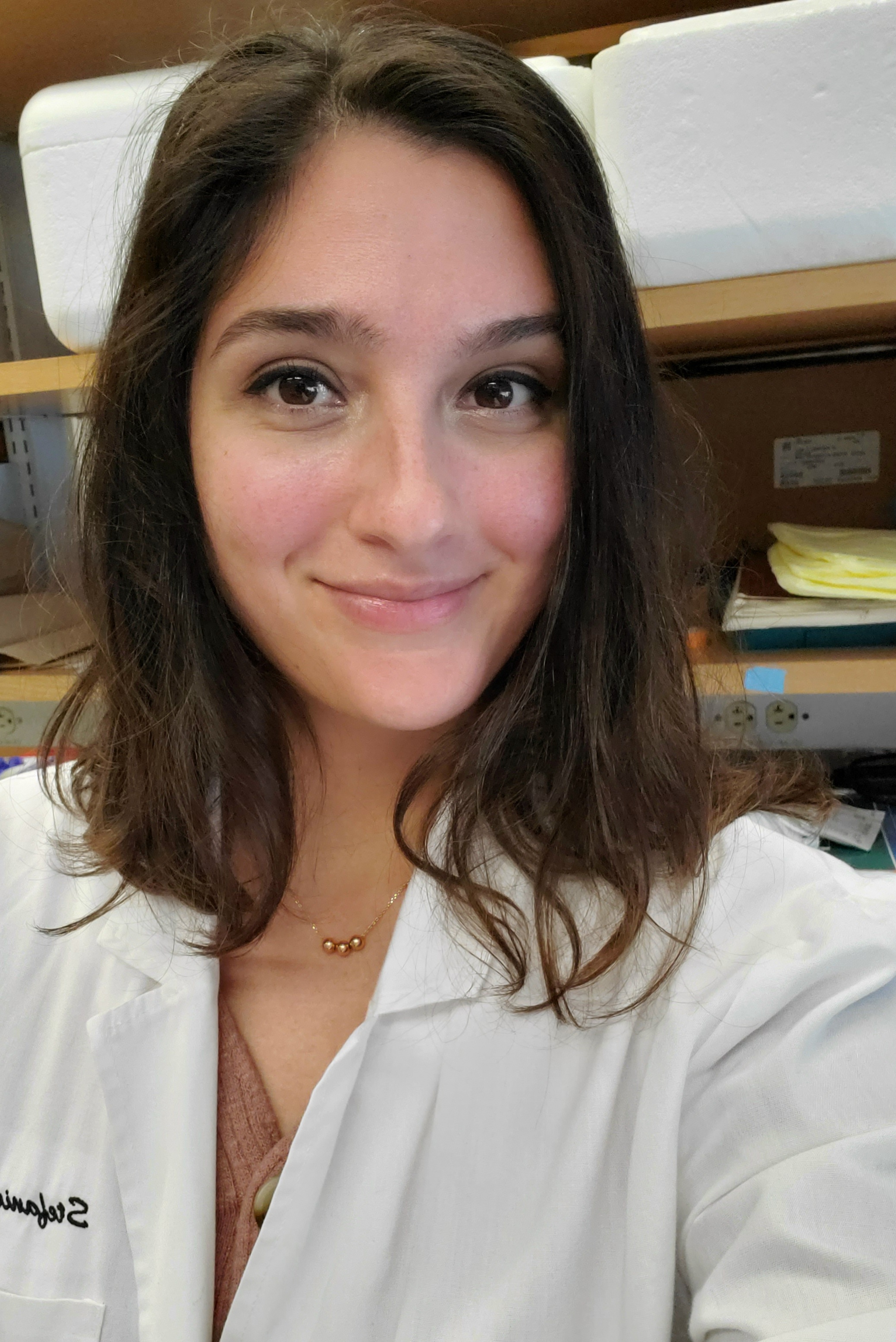Pick of the posters: Neuroscience 2023

At this year’s Neuroscience 2023 (Washington, DC, USA; 11–15 November), the annual meeting of the Society for Neuroscience, we took a trip around the poster hall, picking out our favorites and those we thought you would most like to hear about.
Check out our top four poster selections below.
Human iPSC-derived brain organoids to model the effects of APOE-isoform on SARS-CoV-2 neurotropism
 Aranis Muniz Perez, University of Texas at San Antonio (TX, USA)
Aranis Muniz Perez, University of Texas at San Antonio (TX, USA)
Please describe your poster
I want to understand how APOE4, the leading genetic risk factor for developing late-onset Alzheimer’s Disease, leads to more severe SARS-CoV-2 infection, specifically in the brain. Using human brain organoids, I found that APOE4 inhibitory organoids are more severely infected compared to a neutral isoform (APOE3). I also found that glia are susceptible to SARS-CoV-2 infection, and that following infection, APOE4 astrocytes may be damaged.
What techniques did you use?
Using human induced pluripotent stem cells (iPSCs) derived from subjects with the APOE3/3 and APOE4/4 genotype, I made cortical and ganglionic eminence organoids. I grew them to 200 days in vitro and then infected them with the Delta variant of SARS-CoV-2 for 1 hr. After 7 days, I collected the tissue for RT-qPCR and immunohistochemistry to quantify viral RNA levels and compare expression of different central nervous system (CNS) cell types between genotypes.
Where do you hope to take this project next?
I hope to better understand how APOE4 affects SARS-CoV-2 pathogenesis, especially related to its secretion and potential accumulation within the CNS. I will be performing enzyme-linked immunosorbent assays (ELISAs) to determine pre-infection and post-infection secretion levels, as well as conducting RNAscope to identify the cell types producing APOE. Additionally, I want to understand if the effect of SARS-CoV-2 on glia is related to astrocyte reactivity, and plan on doing ELISAs for interleukin 6 (IL-6) and glial fibrillary acidic protein (GFAP). Since there are emerging links between Alzheimer’s and SARS-CoV-2 infection, I believe these experiments are key to elucidating the potential mechanisms underlying this.
Microglial phagocytosis of SDN neurons is a function of estradiol-induced mast cell degranulation
 Christie Dionisos, University of Maryland (MD, USA)
Christie Dionisos, University of Maryland (MD, USA)
Please describe your poster
My poster looked at estradiol and mast cell-mediated microglial phagocytosis of sexually dimorphic nucleus (SDN) neurons. Essentially, I study sex differentiation in neurodevelopment. There is a robust sex difference in the brain in SDN volume, and we wanted to figure out where that sex difference comes from. We found out the size difference between sexes was due to microglial phagocytosis – in females, microglia phagocytose more neurons than in males, leading to a smaller SDN. We took this one step further to discover why microglia in males phagocytose fewer neurons than in females. There is a unique mast cell population in the brain that shows up at the exact same time that this phagocytosis happens and then goes away. We investigated if degranulating mast cells has an effect on microglia to decrease phagocytosis of SDN neurons only in males, dictating the sex difference of SDN size. We found that degranulation actually decreased the SDN of males, which is opposing to our hypothesis that female (and male) SDNs would increase in size if microglia aren’t eating the SDN neurons. Opposing data is exciting though, as it allows us to ask more questions.
What techniques did you use?
We did intracerebroventricular injections to administer the mast-cell degranulator 48/80. We ran behavioral tests such as the odor preference test in adulthood to test the long-term effects of altered SDN size. We also used immunohistochemistry techniques to measure SDN size and microglial phagocytosis.
Where do you hope to take this project next?
We want to better understand the source of this robust sex difference in the SDN and how it is hormonally regulated. This small nucleus in the preoptic area of the hypothalamus is associated with sex odor preference, so there’s a lot there functionally to work with and gain insight into. In general, we want to gain a better understanding of neuroimmune crosstalk – how our neurons, microglia and mast cells work together during this critical time frame to shape sex differentiation in development and through adulthood.
VTA GABA neuron inhibitory plasticity type is input-specific
 Seth Hoffman, Brigham Young University (UT, USA)
Seth Hoffman, Brigham Young University (UT, USA)
Please describe your poster
The poster is focused on plasticity within the ventral tegmental area (VTA), which regulates feelings of reward via dopamine release to different areas of the brain. The gamma-aminobutyric acid (GABA) cells that innervate those dopamine cells control dopamine release and therefore control feelings of reward, especially in the context of substance use disorder. In response to drug exposure, synaptic connections in the VTA can be rewired through synaptic plasticity, which is thought to be responsible for the pathology of drug dependence. We found that VTA GABA cells exhibit two different types of plasticity, inhibitory long-term potentiation (iLTP) and inhibitory long-term depression (iLTD), when exposed to a 5 Hz stimulus. This is unique because, usually, you only get one type of plasticity per one cell type; seeing two different types of plasticity within a single cell type for a single condition stimulus is quite rare. Since VTA GABA cells receive GABAergic projections from both inside and outside the VTA, we hypothesized that plasticity type could be due to different input sources.
What techniques did you use?
We investigated input-specific projections to these GABA cells in the VTA to see if the plasticity was different. We did this through optogenetic labeling of inputs to the VTA GABA cells from channelrhodopsin injections of our projection sites, so the lateral hypothalamus (LH) and the rosotromedial tegmental nucleus (RMTg). We then recorded activity in the VTA GABA cells that had been innervated by those projections. We were able to isolate circuits using this technique and then we used whole-cell patch clamping to record VTA GABA-cell plasticity. We found that VTA GABA-cell plasticity is input-dependent and that we can tease apart which GABA cells give us iLTP and which give us iLTD. This will help us understand how abusive substances like cocaine or morphine impact plasticity and induce maladaptive plasticity in the VTA.
Where do you hope to take this project next?
We’re going to look at different substances like morphine and cocaine, and maybe some polydrug studies, to see how they affect plasticity and the VTA and if that’s also input-specific.
SARS-CoV-2 enhances hyperactivity of medial prefrontal cortex pyramidal neurons in cocaine self-administered HIV-1 Tg rats
 Stefanie Cassoday, Rush University (IL, USA)
Stefanie Cassoday, Rush University (IL, USA)
Please describe your poster
My poster examines the effects of COVID-19 on neuroHIV and cocaine abuse, as all three epidemics are associated with neurocognitive impairments. But we don’t know how COVID-19 exacerbates neuroHIV and cocaine-induced neuronal dysfunction in brain regions regulating neurocognition, like the medial prefrontal cortex (mPFC). Using electrophysiology, I characterized SARS-CoV-2-induced mPFC pyramidal neuron dysfunction, using recombinant SARS-CoV-2 spike protein or plasma-isolated IgGs from patients with severe COVID-19. We found that neuroHIV and cocaine-induced cortical neuron dysfunction is enhanced by SARS-CoV-2 spike protein/IgGs from COVID-19 patients.
What techniques were used in this project?
We used an integrated design approach for this study, which included a cocaine self-administering rat model of neuroHIV (HIV-1 transgenic rat model), associated with behavioral (drug-taking and seeking) and electrophysiology (whole-cell patch-clamping) testing. Additionally, human plasma IgGs were isolated using agarose beads.
Where do you hope to take this project next?
After finishing this project, I am interested in exploring the mechanism underlying the neuronal dysfunction that we found. I want to investigate the potential alterations in membrane ion channels and related signaling that regulate the excitability of mPFC pyramidal neurons. Additionally, as there are various strains of COVID-19 that are associated with varying pathogenicity, it would also be fascinating to see if they could exert varying effects on altering neuronal activity.